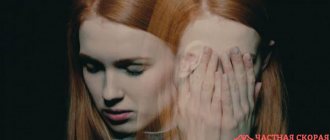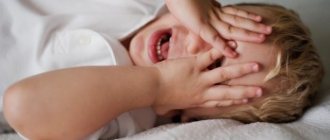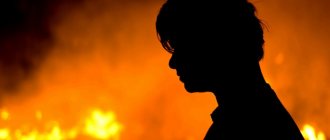Panic attacks at night are sudden attacks of anxiety and fear (most often fear of death) that occur at night or during sleep and are accompanied by severe autonomic symptoms - palpitations, a feeling of shortness of breath, heavy sweating, dizziness. Regular panic attacks are called panic disorder.
The causes of panic attacks during sleep are still unknown. It is believed that they are based on a disruption of the functioning of biologically active substances (norepinephrine and gamma-aminobutyric acid). In 15% of cases, there is a hereditary predisposition when similar conditions occur in close relatives.
A psychotherapist diagnoses and treats panic attacks.
Provoking factors include:
- severe stress, conflicts, childhood experiences and psychological trauma
- abuse of strong coffee, alcohol
- excessive physical activity, mental stress
- hormonal metabolism disorders, injuries and previous infectious diseases of the brain
Less common are panic attacks with two or three symptoms, the so-called minor attacks. They are not accompanied by a feeling of fear and imitate other diseases - heart pathology, dysfunction of the endocrine glands (for example, the thyroid gland).
Such patients have been observed and treated for a long time by therapists, cardiologists and neurologists with a diagnosis of VSD or neurocirculatory dystonia. If treatment from other specialists helps poorly or has no effect at all, you need to consult a psychotherapist.
Causes
Experts identify the following causes of nightmares:
- stress;
- post-traumatic syndrome;
- complexes and fears;
- overeating before bed;
- some chronic diseases;
- use of drugs, alcohol;
- physical and psycho-emotional overload;
- uncomfortable environment (noise, light);
- breathing problems;
- traumatic brain injuries;
- taking certain medications;
- sleepwalking;
- heredity.
Adviсe
How parents should behave depends on many factors. First of all, you need to find out what kind of childhood night terrors torment the little person.
It is important to ask the child what kind of night terror haunts him, who the main characters are in it. You need to calm the child down, show that adults are always with him, they are ready to help at any moment.
It is worth explaining to the child that there are no monsters in reality. Parents don't buy the toy they want - the children get upset. This situation may haunt them in their dreams. Here you just need to minimize the amount of stress during the day and sort out the difficulties.
Adults are advised not to watch scary movies or cartoons with their children, not to read scary fairy tales, and not to turn on the news before bed. This information is alarming.
If necessary, you can leave a night light or the door ajar. The child's night terrors will not go away quickly, but he will be able to calm down as soon as possible. It is important for a little person to realize that there is no threat to his life.
There is no need to overload your baby with circles and sections. Due to his age, he needs a lot of time for games and entertainment, this is how he explores the world and learns.
You can buy your child a dream catcher and tell him about its purpose. Experts also recommend using amulets that have protective properties. It is necessary to monitor your child’s sleep patterns; it is important that sleep is adjusted. It’s good if the baby has the opportunity to sleep during the day and relax in the car during a trip to kindergarten.
A quiet and comfortable environment helps to get rid of children's night fears. There is no need to disturb the child while he is sleeping. It is forbidden to make loud volumes on the radio and TV; all noisy household appliances must be turned off. Ideally, adults should talk to each other in a low voice or whisper at night.
Showing concern for your child, devoting more time to him, listening to your child’s problems is another way to overcome children’s night terrors.
Treatment
As a rule, you can cope with nightmares without the use of medications, but with the help of communication with a psychologist.
However, the treatment program depends on the identified causes of nightmares. Often, to normalize sleep, it is necessary to cure the underlying disease (apnea, alcoholism, drug addiction).
When treating nightmares, taking sleeping pills, hormonal drugs (melatonin), and natural sedatives (valerian, lemon balm, etc.) may be indicated.
4.Do the exercise
Have you heard anything about the vagus nerve? This is a paired nerve that runs from the brain to the abdomen and can help reduce anxiety if you train it.
To do this, you need to sit or lie down comfortably and turn your head to the right “all the way.” That is, until the moment you can and feel comfortable. The gaze should also be directed to the right and directed as far as possible. Stay in this position until you feel like yawning, taking a deep breath or sighing, then do the same on your left side.
Prevention
As preventive measures, doctors recommend:
- establish sleep and wakefulness patterns;
- improve sleep conditions (silence and darkness in the bedroom, regular ventilation);
- avoid stressful situations;
- do not overeat before bedtime;
- limit alcohol consumption (especially in the evening);
- do not abuse caffeine (no more than two cups of tea or coffee per day);
Most people have experienced various sleep disorders, including nightmares. If all this negatively affects your quality of life, seek help from a medical specialist. The doctor will identify the cause of the disorder and select an effective treatment program.
Night terrors
K.Yu.Mukhin
Night terrors (NS) or pavor nocturnus is a paroxysmal non-epileptic disorder that occurs during the slow-wave sleep phase and is manifested by a complex of psychomotor and autonomic disorders followed by amnesia. Nightmares, unlike night terrors, occur during the REM phase of sleep, manifest as frightening dreams and are not amnesiac. According to the modern classification of sleep disorders, night terrors are classified as parasomnias or disorders of awakening from slow-wave sleep (5). Parasomnias also include sleepwalking, nocturnal cluster headache, chronic nocturnal paroxysmal hemicrania, nocturnal yactation (jactacio capitis nocturna). The concept of parasomnias was proposed by Gastaut & Broughton in 1965 (3). The authors identified 3 most important features characteristic of this group of diseases:
• paroxysmal onset soon after falling asleep, • sleep interruption, • occurring exclusively during the slow-wave sleep phase.
Subsequent studies using video-EEG monitoring and polysomnography proved the non-epileptic nature of parasomnias and the absence of their relationship with epilepsy (1, 2).
In the etiology of night fears, the hereditary factor is recognized as the leading one. Autosomal dominant inheritance with incomplete penetrance is assumed (5). Among relatives of probands suffering from night terrors, cases of various forms of parasomnia, mainly sleepwalking, are often found. Some authors pay attention to exogenous factors in the occurrence of night fears, in particular, the presence of a chronic traumatic situation (4). Psychological testing of children suffering from night terrors rarely reveals increased levels of anxiety and aggressiveness.
The prevalence of night terrors is not precisely known. Most studies report an incidence of 1 to 3% in populations of children aged 1 to 14 years (1, 5).
Clinic The disease begins in childhood in a wide age range from several months to 15 years. Night terrors debut with maximum frequency at the age of 5–7 years, with some predominance in boys. Clinical manifestations of night terrors are typical and stereotypical. A triad of symptom complexes is characteristic: mental, motor and vegetative. A child's sleep is suddenly interrupted by a cry, usually 30 to 60 minutes after falling asleep. He sits up in bed; there is a grimace of fear on his face. Possible psychomotor agitation, chill-like hyperkinesis, visual hallucinations of frightening content. When the mother tries to calm, hug or put the child to bed, the patient does not recognize her and pushes her away. It is not possible to make contact with the child. Autonomic disorders are observed: tachycardia, tachypnea, mydriasis. The duration of the attack varies from 30 seconds to 10 - 15 minutes, averaging 2 - 5 minutes. After the end of the attack or upon awakening in the morning, these conditions are amnesic. The frequency of attacks is extremely variable from several paroxysms during one night to single ones over the entire period of the disease. In general, NS is characterized by a high frequency of attacks.
A routine neurological examination reveals no pathology, and intelligence is always preserved. Neurotic traits of personality development are often stated.
Video-EEG monitoring and polysomnographic research are of utmost importance in diagnosing night terrors. An EEG study does not reveal epileptic activity, either in the interictal period or during an attack. Polysomnography clearly shows the occurrence of paroxysms exclusively in the slow-wave sleep phase, usually in stages 3-4 (6). During night terrors, the EEG may show generalized symmetrical hypersynchronous delta activity, different from slow-wave sleep patterns. Some authors note a disturbance in the structure of sleep during night terrors (especially in the first 30–60 minutes after falling asleep): shortening of the slow-wave phase and lengthening of REM sleep (5). Differential diagnosis should be made with other parasomnias and with partial forms of epilepsy. During complex partial epileptic paroxysms, the affect of fear is less pronounced and motor symptoms predominate. The EEG often shows a regional peak - wave activity, usually in the frontal or temporal leads.
Treatment In cases of rare, episodic night terrors that occur exclusively during periods of emotional stress or during fever, no treatment is required. Treatment is prescribed for frequent night fears that cause anxiety in the patient or his parents, as well as when clinical symptoms of the disease persist after 15 years of age. The drug of choice is diazepam (Sibazone, Valium, Seduxen). Diazepam is prescribed orally in an average dose of 2.5 - 5 mg once at night. It is possible to use nitrazepam (radedorm) 2.5 - 5 mg at night or clonazepam (antelepsin, rivotril) 0.5 - 2 mg at night, which are highly effective in relieving NS, but also highly toxic. In some cases, a positive effect can be achieved by prescribing phenibut at a dose of 250-500 mg once at night (the drug has minimal side effects). The duration of the course of drug therapy varies from 1-2 to 6 months. The use of antiepileptic drugs is contraindicated! Individual or family psychotherapy may be used (4).
The forecast for night terrors is absolutely favorable. In the vast majority of cases, the disease goes away on its own after 15 years. In some patients, rare episodes of NS persist at a young age and do not require treatment. Cases of transformation of the NS into sleepwalking have been described.
Literature:
1. Badalyan L.O., Temin P.A., Zavadenko N.N. Awakening disorders in children: night terrors and sleepwalking. Journal of Neuropathology and Psychiatry named after. S.S. Korsakov. - 1991. - T. 91. - N 8. - P. 108 - 111.
2. Diagnosis and treatment of epilepsy in children ed. P.A. Temin, M.Yu. Nikanorova, M. - 1997. - p. 476 - 486.
3. Gastaut H., Broughton RJ A clinical and polygraphic study of episodic phenomena during sleep Biol. Psychiatry. - 1965. - V. 7. - p. 197-221.
4. Hurwitz TD, Mahowald MW, Schenck Ch. Et al A retrospective outcome study and review of hypnosis as treatment of adults with sleep walking and sleep terror — J. Nerv. Ment. Dis. - 1991. - V. 179. - p. 228 - 233.
5. Masand P., Popli AP, Weilburg GB Sleepwalking Am. Fam. Physi-cian. - 1995. - V. 51. - N 3. - p. 49-54.
6. The treatment of epilepsy Ed. E. Willie. - Philadelphia, 1993. - p. 698-702.
Where does the fear of falling asleep come from?
The disorder is caused by the fear of losing control. When falling asleep, a person loses the ability to control sensations in the body and events around.
The fear of falling asleep comes from ancient times. Primitive people perceived the sleeping period as a danger of being eaten by predators or killed by enemy tribes, and losing property.
In the animal world, large predators have the deepest sleep, since the threat to them from other animals is minimal. The deep phase in carnivorous mammals accounts for 37% of total sleep, and in small rodents it is 3%.
The causes of hypnophobia or, as it is also called, clinophobia, somniphobia, are varied.
- Children's fears, formed under the influence of watching horror films or hearing horror stories. The child's psyche poorly distinguishes the imagined from the real, and has increased suggestibility. Therefore, children often make frightening scenes from films so realistic that fictional horror films accompany the child in his dreams and in reality. As for the horror stories they hear, a rich child’s imagination can very vividly reflect in the minds and frighten children more than what they see. It all depends on children's imagination. Fears acquired in childhood can accompany a person into adulthood if they are not stopped in time.
- Nightmarish dreams that take away a person’s desire to sleep.
- A stressful event experienced while asleep. The man fell out of bed in a sleepy state and was very frightened. Subsequently, he developed a fear of sleep.
- In impressionable people with a developed imagination, a phobia appears after communicating with a hypnophobe. The patient tells the interlocutor about his fears. The suggestible person easily transfers them to himself. At night, the imagination intensifies significantly, giving rise to absurd, frightening fantasies.
- Clinophobia manifests itself as a result of saving time. A person is afraid to fall asleep because he believes that he will waste time, will not have time to cope with important matters, or will lose the opportunity to have fun.
- There are specific causes of clinophobia. For example, the mother of a newborn child is afraid to fall asleep, as she will lose the ability to watch her still helpless baby.
- A common cause of somniphobia is fear of death. This is especially true for people with cardiovascular diseases. The fear of having a stroke or heart attack while sleeping is so strong that a person is afraid to fall asleep. In a sleeping state, people are deprived of the ability to control what is happening. Obviously, it is this fact that provokes the fear that the patient will not be able to feel painful sensations and take the necessary measures, and, as a result of unprovided medical measures, will die in his sleep.
- The fear of being buried alive arises from the fear of falling into lethargic sleep. This state is characterized as deep sleep of a long duration, during which the body supposedly independently supports vital functions, and nothing threatens it. However, the person sleeps so soundly that it is impossible to wake him up. Breathing and heartbeat are so weakly expressed that they are sometimes difficult to detect. As a result, the sleeper is declared dead, which creates a fear of intravital burial. Nikolai Vasilyevich Gogol suffered from a similar phobia.
In his youth, the great writer suffered from malaria, which led to encephalitis. The brain inflammation was cured, but the consequences of the disease remained with the writer for life. Nikolai Vasilyevich periodically experienced severe fainting, followed by deep sleep. The writer was terribly afraid that during such a dream he would be considered dead and buried alive.
There is a legend that N.V.’s fears Gogol was still justified. It happened as follows. The writer loved his friend's wife very much. After the woman's death, he was so depressed that he fell asleep, and so deeply that he fell into a lethargic sleep. Gogol was mistaken for dead and buried. These data were allegedly confirmed during the excavation of the body during the restoration of the cemetery. The buried person was in an unnatural position, and his clothes were torn. In reality, such an incident did not happen; it was made up.
It is worth reassuring to some extent those who are afraid of lethargic sleep. In fact, this is a fictitious concept and is rejected by official medicine. There is a term “lethargy”, meaning weakness, malaise, loss of strength. However, it develops as a result of lack of sleep.
What kind of nightmares do you have?
Bad dreams come to a person who is in deep sleep (rapid phase), usually in the second half of the night, in the morning. This period is easy to recognize by the rapidly moving eyes of a sleeping person.
Categories of scary dreams include:
- Pursuit, flight from danger.
- Fear of heights, falling.
- Serious illnesses, death of one’s own or of friends and relatives.
- Natural disasters and destruction.
- Mystical creatures, paranormal phenomena.
- A tragedy or terrible event experienced in real life.
The nightmare of losing loved ones is a fairly common type of nightly dream.
After such dreams, a person cannot sleep, feels weak, tired, unwell, and is haunted by daytime sleepiness and mild attacks of depression. All these symptoms worsen the quality of life. But they disappear after a sound and restful sleep.
If nightmares are regular, then serious diseases and disorders of the body are added to the above symptoms:
- Severe depressive state.
- Diseases of the cardiovascular system.
- Excess weight to obesity.
Panic attacks. Difficulties in diagnosis.
People suffering from the symptoms of panic attacks usually do not know where to turn. They visit the offices of a therapist, cardiologist, endocrinologist, psychiatrist, psychologist, but doctors do not detect any disturbances in the functioning of the body. Of course, it is advisable to undergo all possible examinations and pass all the necessary tests in order to exclude the development of serious physiological abnormalities. However, if, in the end, they tell you that you are absolutely healthy, but anxiety, tachycardia, insomnia and other symptoms continue to torment you, then most likely you suffer from panic disorder, which means the problem lies in a disruption of the autonomic nervous system , which can only be identified by an experienced neurologist-vegetologist.
Some patients with signs of panic attacks are diagnosed with vegetative-vascular dystonia (VSD) and told that they will have to live with such symptoms all their lives, alleviating them with medications: antidepressants and tranquilizers.
“I went to all the doctors because there were a lot of symptoms: my heart, shortness of breath, blood pressure, my stomach, bones, muscles ached, I felt constant anxiety. At first, rare panic attacks grew into a daily norm. The neurologist prescribed Coaxil, but the pills made me feel worse. I drank Coaxil for three months and barely got off it. Then the therapist prescribed me adaptol. It made me feel better, but only while I was drinking it, and as soon as I stopped drinking, everything started all over again. Everything was useless until I learned from friends about the “Clinical Center for Autonomic Neurology”,” patient, Arthur (46 years old).
The deep misconception that VSD and panic attacks cannot be treated can be dispelled if you visit a doctor who specializes specifically in disorders of the autonomic nervous system. Panic attacks can be treated and diagnosed! The main thing is to know where and how this can be done.
Scary to sleep
Sometimes nightmares are accompanied by intense panic attacks. A person may scream, gasp, or thrash around during sleep. Sometimes such actions frighten the sufferer more than a nightmare.
“Sometimes I find myself screaming horribly in the middle of the night, and I find it hard to believe that I can scream so loudly. The next morning my throat hurts... I wouldn’t be able to scream like that even during the day if I tried,” shares a user named Joshua.
However, screaming is a relatively harmless part of the nightmare. It’s much more scary when a person sleeping suddenly begins to behave like someone who is awake. A person can talk, laugh, cry while sleeping, rearrange things on the nightstand, put on and take off shoes.
Doctors call this behavior parasomnia. It is defined as a disorder that causes unusual behavior during sleep. Usually a somnambulist walks, eats or talks with his eyes open, but without awareness of what is happening.
If left unchecked, parasomnia can be very traumatic. On social networks, a girl under the nickname Jen retells the story in horror: “Yesterday my mother called me. She was rushed to hospital after a nightmare caused her to jump out of bed and hit the wall. She now has seven surgical staples in her head!”
“I’m afraid to fall asleep again”2
Photo: Global Look Press/imago-images/Ute Grabowsky
Panic attack. Emergency self-help.
First, learn how to manage your panic attacks yourself to control them and reduce the intensity of your panic attack symptoms.
Try practicing breathing techniques.
Breathe through your diaphragm (belly), in through your nose and out through your mouth slowly and calmly. For example, for 5 counts – inhale, for 10 – exhale.
“Some patients benefit from progressive muscle relaxation. If your muscles are very tense during a panic attack, try tightening your facial muscles: tense your jaw for 8 seconds - then relax, tense your lips for 8 seconds - relax. Repeat the exercise with your arms (palms, forearms) and switch to the next muscle group, for example, the calf muscles, the feet. Alternate tension and relaxation of all parts of the body will help relax the muscles and distract thoughts,” recommendations of a neurologist-vegetologist (“Clinical Center for Autonomic Neurology”).
During a panic attack, try to distract yourself and not think about the symptoms that are bothering you. Use psychological techniques. Visualize some place where you felt good: a house, a vacation spot, a cottage, a forest, a sandy beach - whatever your heart desires. And imagine in detail the entire environment that surrounds you there: a soft chair, a fluffy cat, the smell of pine trees, the crunch of branches under your feet, birdsong, warm sand, etc. Think in advance about where it would be better for you to “go” when you have another panic attack in order to distract your thoughts from its symptoms.
Keep a diary of panic attacks that you can refer to in critical situations. This way you can remind yourself that there is nothing to be afraid of, and the next panic attack will soon pass.









